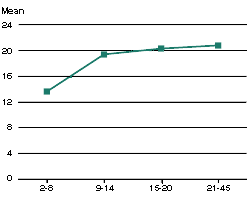| Table 1. Percentage of provider sessions with simulated clients in which expected provider behaviors occurred, and correlation between occurrence of item and length of counseling session |
| Behavior |
% |
Correlation |
| (N=114) |
| General questions asked or action taken by provider |
| How old is client |
96 |
-.11 |
| How many children does she have |
96 |
-.04 |
| Does client want more children |
7 |
.19* |
| What methods has client used/is she currently using |
82 |
-.01 |
| How was client using the rhythm method |
12 |
.11 |
| What was date of last menstruation/whether pregnancy is suspected |
97 |
.02 |
| Performed or wanted to perform pelvic exam |
3 |
.07 |
| Method options offered or action requested by provider |
| Rhythm |
24 |
.16 |
| Condoms |
82 |
.27* |
| Vaginal tablets |
79 |
.28* |
| Pill |
95 |
.23* |
| DMPA |
88 |
.19* |
| IUD |
84 |
.20* |
| Tubal ligation |
26 |
.14 |
| Client asked to choose a method |
96 |
.17 |
| DMPA contraindications or related question asked by provider |
| Vaginal bleeding |
3 |
-.03 |
| Date of last Pap smear |
25 |
.13 |
| Family history of breast cancer |
5 |
.01 |
| Whether client knows how to do a breast exam |
7 |
.14 |
| Whether client has hard formations in the breast |
4 |
-.07 |
| Whether client has liver problems or yellow skin |
32 |
-.06 |
| DMPA mechanism of action told by provider |
| Injection would stop ovulation |
36 |
.05 |
| Cervical mucus would thicken |
10 |
.14 |
| DMPA use instructions given by provider |
| First injection administered in first five days of menses |
70 |
.16 |
| Injection administered in the buttocks |
46 |
.28* |
| Following doses given every 3 months |
93 |
.15 |
| Allowable window surrounding quarterly injection date is two weeks |
4 |
-.12 |
| DMPA side effects/warning signs told to client |
| Menstruation might stop altogether |
84 |
.05 |
| Menstruation may be irregular or spotting may occur |
77 |
.06 |
| Neither amenorrhea nor spotting is sign of illness |
44 |
.06 |
| Weight gain is possible |
37 |
.07 |
| Temporary infertility of 6-12 mos. might follow stopping method |
15 |
.18 |
| Abundant vaginal bleeding requires return visit |
12 |
.01 |
| Instructions on barrier methods given by provider |
| Condoms/vaginal tablets should be used while waiting for injection |
18 |
.04 |
| Coitus must be initiated with condom on |
47 |
.10 |
| Condom must be removed with penis still erect |
20 |
.14 |
| Each coitus requires new condom |
38 |
.21* |
| Vaginal tablet must be inserted 15 minutes before coitus |
54 |
.13 |
| Client must be prone for insertion of tablet |
29 |
.15 |
| Tablet is effective for one hour |
18 |
.20* |
| Each act of coitus requires new tablet |
25 |
.05 |
| Client must avoid douching during the hours following coitus |
24 |
.19* |
| Follow-up question asked or actions taken by provider |
| Asked whether client had understood |
23 |
.14 |
| Verified client's response by asking specific questions |
3 |
-.02 |
| Told client to return if she had any doubts |
12 |
.02 |
| Client given information leaflet |
27 |
.31* |
| *p<.05, two-tailed test. |
![]()
![]()
